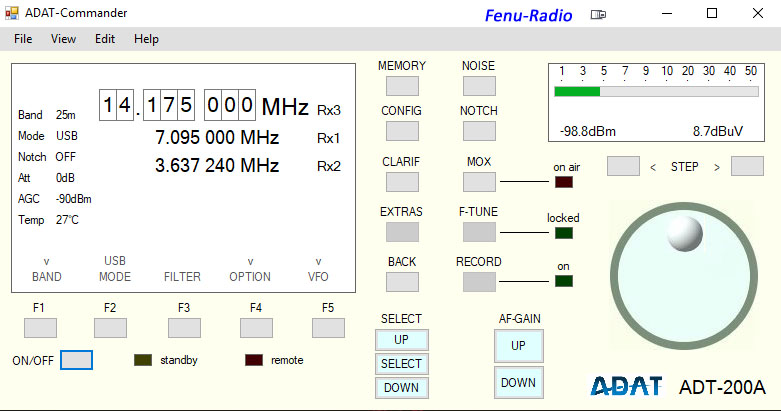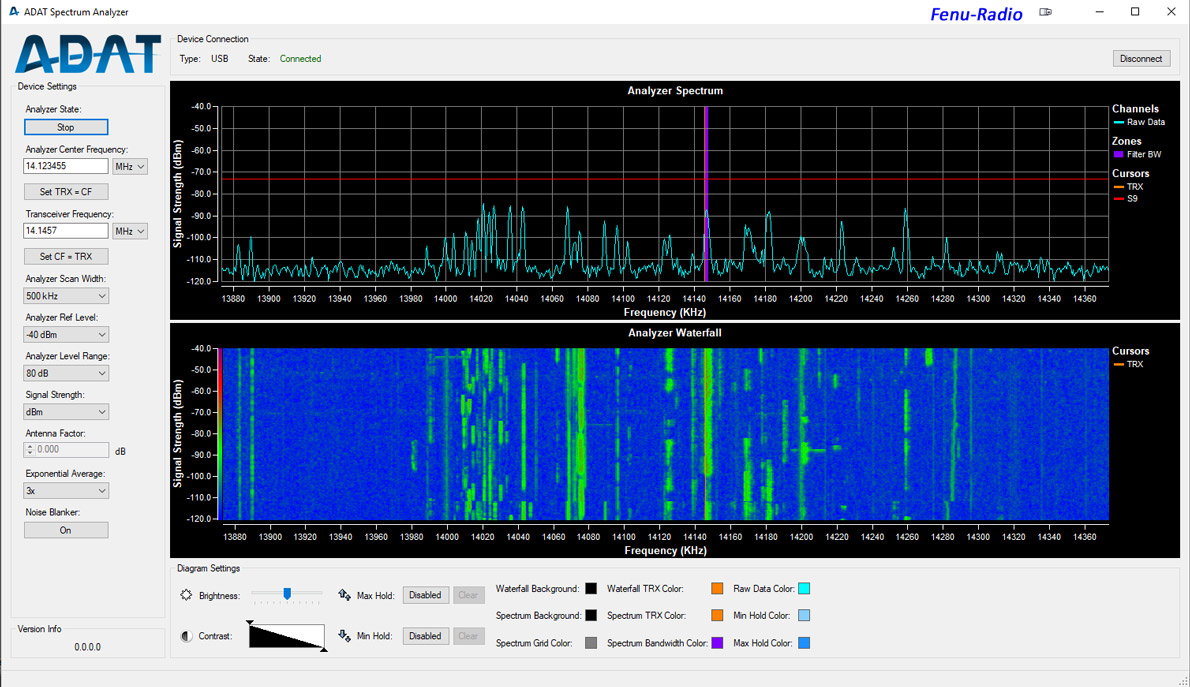|
ADAT ADT-200A
A software-defined amateur radio from Swiss production, was around 2008, the radio amateur scene sit up. Hans Zahnd HB9CBU, presented to the public the ADAT ADT-200A, a fully digital TRX with excellent technical features. The ADT-200A was then put through its paces by several respected testers. Also Ulrich Rhode N1UL, partner of the renowned company Rhode & Schwarz, had the ADT-200A on the table and certified it top marks. The ADT-200A is rarely found. Therefore, little is known about him. He is a true exotic radio. Radio amateurs enjoying high-tech equipment and a penchant for the special may be the main clientele for this particular device. The ADT-200A is a compact and ruggedly built device that comes across quite inconspicuously. It radiates the cool and restrained charm of a measuring device. And he is, according to the developer. The S-Meter of the ADT-200A as well as the Spectrum Display, which can be displayed on the PC screen, are of high precision and can be used for measurement purposes. The S-meter of the ADT-200A has a deviation of max. ± 1.5 dB! The fact of the built-in transmitter part made it impossible for me to borrow for a long time because I am not a radio amateur. Only in the presence of a licensed radio amateur I was allowed to operate the device. So I first had to find someone who had the HB9 radio amateur license and was willing to attend the test sessions. Heinz Stampfl HB9KOC agreed to accompany me during the reception tests. Hans Zahnd HB9CBU, developer of the ADT-200A, then provided the ADT-200A for receiving tests.
The operation of the ADT-200A The ADT-200A is an amateur radio. Accordingly, it is designed for amateur-specific applications. But he still has a small heart for the shortwave listener or for radio amateurs who want to listen now and then in the shortwave radio bands. On the back it has all sorts of antenna inputs and outputs, as well as connections for the audio and PC connection. Nice is, for pure receiving purposes the ADT-200A has a separate BNC antenna connection. This antenna input allows the reception of 10KHz - 30MHz. This is repeatedly protected against overvoltage. The receive signal then passes through a high-quality, tracking preselector (BP) before it is digitized in the ADC (analog-to-digital converter). It is then fed to the DSP where demodulation and filtering takes place. Then it goes on to the DAC (digital / analog converter), where it is analogized to make it audible.
After switching on the device, a self-test is executed first. There
are some relay clicks from inside the unit. The ADT-200A has a
built-in fan that runs permanently. Luckily it is quiet and
therefore hard to hear. After pressing the volume control, I was
astonished to note that the device does not have a built-in speaker!
At first, a matching rear speaker had to be connected. After
connecting the active speakers of the computer, I noticed rattling
noises coming from the speaker. So I provisionally took a passive
loudspeaker of my stereo to exclude that the sounds came about
because of a ground loop. Unfortunately, the rattle was still there!
So it came from the ADT-200A. But in the receiving operation, the
disturbance is not heard. Since I make reception tests practically
only with headphones, a problem got in the way! The ADT-200A has no
regular headphone jack on the front panel. It has a Lemo socket that
combines all the connections for headphones and microphone. So I had
to ask Mr. Zahnd to send me a Lemo plug, so I could make an adapter
with a 3.5mm jack. So it happened and the reception tests and
comparisons could begin. ADAT-Commander
ADAT Spectrum Analyzer
The reception with the ADT-200A In order to determine the reception power of a receiver, a comparison device is necessary. For this I took the Icom IC-R8600. He comes closest to the ADT-200A. It is also a standalone SDR with a 14bit ADC. Various antennas were used: Stampfl Active Dipole, Reuter Kreuzloop / RLA4 / 2E and the old Datong AD370. At
11.9KHz the alpha signals from Russia could be heard again for a
long time. These broadcasts are used for radio navigation of
aircraft, ships and submarines. The ADT-200A brought the transmitter
to the headphones with almost the same audibility as the IC-R8600.
However, Icom had to switch on the preamplifier. Both devices were
placed on CW with a bandwidth of 100Hz. On the long wave BBC4 can be
heard here on 198KHz with quite strong signal every day. This time
the transmitter was disturbed by a local disturbance, a kind of
rattling. The Noiseblanker of the ADT-200A could eliminate the
rattling completely, so that the transmitter was to be taken up
properly. Here, the excellent AM reception of the ADT-200A was
noticeable. Very low noise and a great voice reproduction. In
comparison, the IC-R8600 had a rather dull playback and rushed a bit
more. But his Noiseblanker could eliminate the disturbances
completely. On the medium wave in the late afternoon at 531KHz. Jil
FM from Algeria started to make an impact. Quiet and with heavy
fading. Even with the flexibly adjustable AGC of the ADT-200A fading
could not be removed. What was missed here was a synchronous
detector. This is switchable with the ADT-200A, but is not
implemented in the device firmware, which is a pity. By contrast,
the IC-R8600, with its synch. Detector, was able to deliver the
transmitter much quieter to the headphones. But also not completely
free from fading. So it went on towards shortwave, directly on the
80m amateur radio band. With correctly set AGC at 2.4KHz bandwidth
on LSB, rendering the ADT-200A is simply awesome! Lowest noise and a
completely round and clear speech intelligibility. The Icom was also
very low noise, but still did not come quite close to the clarity of
the ADT-200A. There was a lack of brilliance. At very weak stations
on the sward, both were pretty much on par. In the early evening at
4885KHz, Echo of Hope from South Korea was in fade-in. With this
signal, the IC-R8600 brought the better understandability to the
headphones. This is due to the Synch.- detector. Because the
ADT-200A has none, the typical AM crackling prevented a better
understanding. The 49m band in the late afternoon. The band is
slowly filling up with channels and the adjacent channel
interference is increasing. It depends on steep edge bandwidth
filters. Of course this is not a problem for the ADT-200A. The
digital filters separate the transmitters from one another.
Unfortunately, the bandwidth filters can not be controlled
steplessly. They can only be adjusted roughly in 1KHz steps in AM.
This feature is better done on the more modern IC-R8600. The
bandwidth can be set in 100Hz steps with very high selectivity. Here
is the IC-R8600 at an advantage.
Although the ADAT ADT-200A comes from the beginning of the SDR
amateur equipment, it convinces with its excellent receiver! The
playback in AM is very clear and absolutely low noise. That reminded
me of the
Cubic CDR-3250.
This had a similarly excellent reproduction. Unfortunately, no
synchronous detector is available, although it can be selected in
the menu. Here is a lot of potential given away! In SSB, the
ADT-200A leaves no doubt. Audio reproduction, sensitivity and
selectivity are in no way inferior to the more modern Icom IC-R8600,
surpassing it in the clarity of audio playback. posted: 19.01.2019
|
.jpg)

.jpg)
.jpg)
.jpg)
.jpg)
.jpg)

.jpg)


